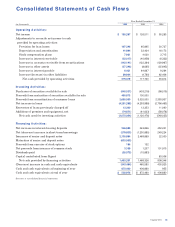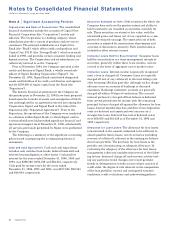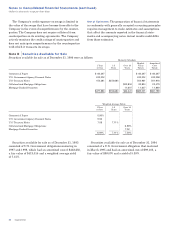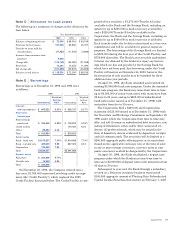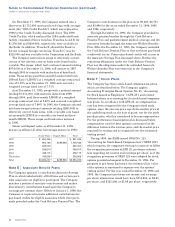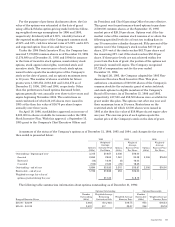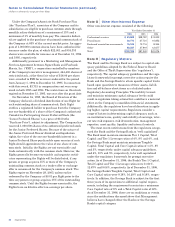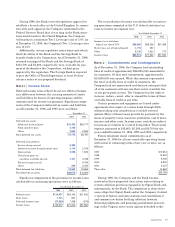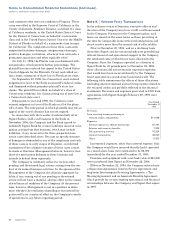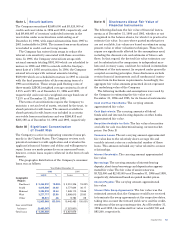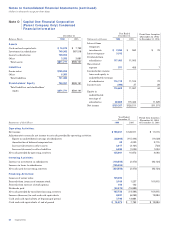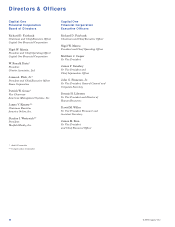Capital One 1996 Annual Report Download - page 52
Download and view the complete annual report
Please find page 52 of the 1996 Capital One annual report below. You can navigate through the pages in the report by either clicking on the pages listed below, or by using the keyword search tool below to find specific information within the annual report.
Note G Other Non-Interest Expense
Other non-interest expense consisted of the following:
Year Ended December 31
1996 1995 1994
Professional services $ 43,968 $28,787 $ 9,203
Fraud losses 26,773 27,721 10,852
Bankcard association assessments 15,045 13,116 8,344
Other 46,397 27,919 12,677
Total $132,183 $97,543 $41,076
Note H Regulatory M atters
The Bank and the Savings Bank are subject to capital ade-
quacy guidelines adopted by the Federal Reserve Board
and the Office of Thrift Supervision (the “regulators”),
respectively. The capital adequacy guidelines and the regu-
latory framework for prompt corrective action require the
Bank and the Savings Bank to attain specific capital levels
based upon quantitative measures of their assets, liabili-
ties and off-balance sheet items as calculated under
Regulatory Accounting Principles. The inability to meet
and maintain minimum capital adequacy levels could
result in regulators taking actions that could have a material
effect on the Company’s consolidated financial statements.
Additionally, the regulators have broad discretion in apply-
ing higher capital requirements. Regulators consider a
range of factors in determining capital adequacy, such as
an institution’s size, quality and stability of earnings, inter-
est rate risk exposure, risk diversification, management
expertise, asset quality, liquidity and internal controls.
The most recent notifications from the regulators catego-
rized the Bank and the Savings Bank as “well capitalized”.
The Bank must maintain minimum Tier 1 Capital, Total
Capital and Tier 1 Leverage ratios of 4%, 8% and 4%, and
the Savings Bank must maintain minimum Tangible
Capital, Total Capital and Core Capital ratios of 1.5%, 8%
and 3%, respectively, under capital adequacy guidelines,
and 6%, 10% and 5%, respectively, to be well capitalized
under the regulatory framework for prompt corrective
action. As of December 31, 1996, the Bank’s Tier 1 Capital,
Total Capital and Tier 1 Leverage ratios were 11.61%,
12.87% and 9.04%, respectively. As of December 31, 1996,
the Savings Bank’s Tangible Capital, Total Capital and
Core Capital ratios were 9.18%, 16.29% and 9.18%, respec-
tively. In addition, the Savings Bank is subject for the first
three years of its operations to additional capital require-
ments, including the requirement to maintain a minimum
Core Capital ratio of 8% and a Total Capital ratio of 12%.
As of December 31, 1996, there are no conditions or events
since the notifications discussed above that Management
believes have changed either the Bank’s or the Savings
Bank’s capital category.
50 Capital One
Notes to Consolidated Financial Statements (continued)
(dollars in thousands, except per share data)
Under the Company’s Associate Stock Purchase Plan
(the “Purchase Plan”), associates of the Company and its
subsidiaries are eligible to purchase common stock through
monthly salary deductions of a maximum of 15% and a
minimum of 1% of monthly base pay. The amounts deduct-
ed are applied to the purchase of unissued common stock of
the Company at 85% of the current market price. An aggre-
gate of 1,000,000 common shares have been authorized for
issuance under the plan, of which 822,001 and 934,355
shares were available for issuance as of December 31, 1996
and 1995, respectively.
Additionally, pursuant to a Marketing and Management
Services Agreement between Signet Bank and Fairbank
Morris, Inc. (“FMI”), a corporation controlled by members
of the Company’s executive management, 464,400 shares of
restricted stock, at the then fair value of $16.00 per share,
were awarded to FMI for services rendered for the period
from January 1, 1994 to December 31, 1995. In connection
with this award, $3,715 in compensation cost was recog-
nized in both 1995 and 1994. The restrictions on this stock
expired on November 15, 1995, one year after the grant date.
On November 16, 1995, the Board of Directors of the
Company declared a dividend distribution of one Right for
each outstanding share of common stock. Each Right
entitles a registered holder to purchase from the Company
one one-hundredth of a share of the Company’s authorized
Cumulative Participating Junior Preferred Stock (the
“Junior Preferred Shares”) at a price of $150 (the
“Purchase Price”), subject to adjustment. The Company has
reserved 1,000,000 shares of its authorized preferred stock
for the Junior Preferred Shares. Because of the nature of
the Junior Preferred Shares’ dividend and liquidation
rights, the value of the one one-hundredth interest in a
Junior Preferred Share purchasable upon exercise of each
Right should approximate the value of one share of com-
mon stock. Initially, the Rights are not exercisable and
trade automatically with the common stock. However, the
Rights generally become exercisable and separate certifi-
cates representing the Rights will be distributed, if any
person or group acquires 15% or more of the Company’s
outstanding common stock or a tender offer or exchange
offer is announced for the Company’s common stock. The
Rights expire on November 29, 2005, unless earlier
redeemed by the Company at $0.01 per Right prior to the
time any person or group acquires 15% of the outstanding
common stock. Until the Rights become exercisable, the
Rights have no dilutive effect on earnings per share.





